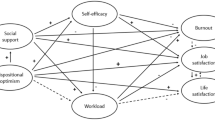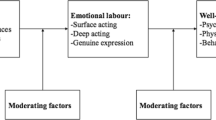Abstract
As the field of school psychology faces critical shortages, investigations of work factors affecting job satisfaction and burnout are of increasing importance. One such factor is emotional labor, which is defined as the work of managing one’s emotions and emotional expressions so as to align to the expectations of the job or profession. In this study, practitioners (N = 192) were surveyed regarding their work experiences, recognition of display rules (standards that guide employees’ emotional expression), surface acting (the form of emotional labor in which employees manage their external emotional expression), job satisfaction, and burnout (consisting of emotional exhaustion, depersonalization, and personal accomplishment). Multiple regression analyses showed that display rule recognition was positively related to surface acting, and surface acting was positively related to emotional exhaustion and depersonalization while negatively related to job satisfaction and personal accomplishment. Results suggest that emotional labor may be an important aspect of the work of school psychologists—impacting both job satisfaction and burnout. Limitations and implications for research and practice are discussed.
Similar content being viewed by others
References
Bacharach, S. B., Bamberger, P., & Conley, S. (1991). Work-home conflict among nurses and engineers: mediating the impact of role stress on burnout and satisfaction at work. Journal of Organizational Behavior, 12, 39–53.
Becker, T. E. (2005). Potential problems in the statistical control of variables in organizational research: a qualitative analysis with recommendations. Organizational Research Methods, 8, 274–289. doi:10.1177/1094428105278021.
Bolnik, L., & Brock, S. E. (2005). The self-reported effects of crisis intervention work on school psychologists. The California School Psychologist, 10, 117–124. doi:10.1007/BF03340926.
Carlson, D., Ferguson, M., Hunter, E., & Whitten, D. (2012). Abusive supervision and work-family conflict: the path through emotional labor and burnout. The Leadership Quarterly, 23, 849–859. doi:10.1016/j.leaqua.2012.05.003.
Chau, S. L., Dahling, J. J., Levy, P. E., & Dieffendorff, J. M. (2009). A predictive study of emotional labor and turnover. Journal of Organizational Behavior, 30, 1151–1163. doi:10.1002/job.617.
Chi, N., Grandey, A. A., Diamond, J. A., & Krimmel, K. R. (2011). Want a tip? Service performance as a function of emotion regulation and extraversion. Journal of Applied Psychology, 96, 1337–1346. doi:10.1037/a0022884.
Conway, J. M., & Lance, C. E. (2010). What reviewers should expect from authors regarding common method bias in organizational research. Journal of Business and Psychology, 25, 325–334. doi:10.1007/s10869-010-9181-6.
Curtis, M. J., Hunley, S. A., Walker, K. J., & Baker, A. C. (1999). Demographic characteristics and professional practices in school psychology. School Psychology Review, 28, 104–116.
Diefendorff, J. M., & Croyle, M. H. (2008). Antecedents of emotional display rule commitment. Human Performance, 21, 310–332. doi:10.1080/08959280802137911.
Diefendorff, J. M., Croyle, M. H., & Gosserand, R. H. (2005). The dimensionality and antecedents of emotional labor strategies. Journal of Vocational Behavior, 66, 339–357. doi:10.1016/j.jvb.2004.02.001.
Diefendorff, J. M., Richard, E. M., & Croyle, M. H. (2006). Are emotional display rules formal job requirements? Examination of employee and supervisor perceptions. Journal of Occupational and Organizational Psychology, 79, 273–298. doi:10.1348/096317905X68484.
Filter, K. J., Ebsen, S., & Dibos, R. (2013). School psychology crossroads in America: discrepancies between actual and preferred discrete practices and barriers to preferred practice. International Journal of Special Education, 28, 88–100.
Fisk, G. M., & Friesen, J. P. (2012). Perceptions of leader emotion regulation and LMX as predictors of followers’ job satisfaction and organizational citizenship behaviors. The Leadership Quarterly, 23, 1–12. doi:10.1016/j.leaqua.2011.11.001.
Gibson, J. A., Grey, I. M., & Hastings, R. P. (2009). Supervisor support as a predictor of burnout and therapeutic self-efficacy in therapists working in ABA schools. Journal of Autism and Developmental Disorders, 39, 1024–1030. doi:10.1007/s10803-009-0709-4.
Grandey, A. A. (2000). Emotion regulation in the workplace: a new way to conceptualize emotional labor. Journal of Occupational Health Psychology, 5, 95–110. doi:10.1037/1076-8998.5.1.95.
Grandey, A. A., Fisk, G. M., & Steiner, D. D. (2005). Must “service with a smile” be stressful? The moderating role of personal control for American and French employees. Journal of Applied Psychology, 90, 893–904. doi:10.1037/0021-9010.90.5.893.
Grandey, A., Foo, S. C., Groth, M., & Goodwin, R. E. (2012). Free to be you and me: a climate of authenticity alleviates burnout from emotional labor. Journal of Occupational Health Psychology, 17, 1–14. doi:10.1037/a0025102.
Hayes, A. F. (2015). An index and test of linear moderated mediation. Multivariate Behavioral Research, 50, 1–22. doi:10.1080/00273171.2014.962683.
Hobfoll, S. E. (1989). Conservation of resources: a new attempt at conceptualizing stress. American Psychologist, 44, 513–524.
Hochschild, A. R. (1983). The managed heart: commercialization of human feeling. Berkely: University of California Press.
Hosp, J. L., & Reschly, D. J. (2002). Regional differences in school psychology practice. School Psychology Review, 31, 11–29.
Judge, T. A., Woolf, E. F., & Hurst, C. (2009). Is emotional labor more difficult for some than for others? A multilevel, experience-sampling study. Personnel Psychology, 62, 57–88.
Kammeyer-Mueller, J. D., Rubenstein, A. L., Long, D. M., Odio, M. A., Buckman, B. R., Zhang, Y., & Halvorsen-Ganepola, M. D. (2013). A meta-analytic structural model of dispositional affectivity and emotional labor. Personnel Psychology, 66, 47–90. doi:10.1111/peps.12009.
Kenworthy, J., Fay, C., Frame, M., & Petree, R. (2014). A meta-analytic review of the relationship between emotional dissonance and emotional exhaustion. Journal of Applied Social Psychology, 44, 94–105. doi:10.1111/jasp.12211.
Maslach, C., & Jackson, S. E. (1996). Maslach burnout inventory manual. Palo Alto, CA: Consulting Psychological Press.
National Association of School Psychologists. (2010). Model for comprehensive and integrated school psychological services. Retrieved from http://www.nasponline.org/assets/Documents/Standards%20and%20Certification/Standards/2_PracticeModel.pdf
Podsakoff, P. M., MacKenzie, S. B., Jeong-Yeon, L., & Podsakoff, N. P. (2003). Common method biases in behavioral research: a critical review of the literature and recommended remedies. Journal of Applied Psychology, 88, 879–903. doi:10.1037/0021-9010.88.5.879.
Proctor, B. E., & Steadman, T. (2003). Job satisfaction, burnout, and perceived effectiveness of “in-house” versus traditional school psychologists. Psychology in the Schools, 40, 237–243. doi:10.1002/pits.10082.
Roth, P. L., Switzer, F., & Switzer, D. M. (1999). Missing data in multiple item scales: a Monte Carlo analysis of missing data techniques. Organizational Research Methods, 2, 211–232. doi:10.1177/109442819923001.
Rupp, D. E., & Spencer, S. (2006). When customers lash out: the effects of customer interactional injustice on emotional labor and the mediating role of discrete emotions. The Journal of Applied Psychology, 91, 971–978.
Scott, B. A., & Barnes, C. M. (2011). A multilevel field investigation of emotional labor, affect, work withdrawal, and gender. Academy of Management Journal, 54, 116–136.
Shanock, L. R., Allen, J. A., Dunn, A. M., Baran, B. E., Scott, C. W., & Rogelberg, S. G. (2013). Less acting, more doing: how surface acting relates to perceived meeting effectiveness and other employee outcomes. Journal of Occupational and Organizational Psychology, 86, 457–476. doi:10.1111/joop.12037.
Skalski, A. K., Minke, K., Rossen, E., Cowan, K. C., Kelly, J., Armistead, R., & Smith, A. (2015). NASP practice model implementation guide. Bethesda, MD: National Association of School Psychologists.
VanVoorhis, R. W., & Levinson, E. M. (2006). Job satisfaction among school psychologists: a meta-analysis. School Psychology Quarterly, 21, 77–90.
Watson, D., Clark, L. A., & Tellegen, A. (1988). Development and validation of the brief measures of positive and negative affect: the PANAS scales. Journal of Personality and Social Psychology, 54, 1063–1070.
Worrell, T. G., Skaggs, G. E., & Brown, M. B. (2006). School psychologists’ job satisfaction: a 22 year perspective in the USA. School Psychology International, 27, 131–145. doi:10.1177/0143034306064540.
Acknowledgements
This research was supported in part by a grant from the University Committee on Research and Creative Activity at the University of Nebraska at Omaha.
Author information
Authors and Affiliations
Corresponding author
Ethics declarations
The study complied with Institutional Review Board policies of the authors’ institution, and all participants provided consent.
Conflict of Interest
The authors declare that they have no conflict of interest.
Rights and permissions
About this article
Cite this article
Weaver, A.D., Allen, J.A. Emotional Labor and the Work of School Psychologists. Contemp School Psychol 21, 276–286 (2017). https://doi.org/10.1007/s40688-017-0121-6
Published:
Issue Date:
DOI: https://doi.org/10.1007/s40688-017-0121-6




